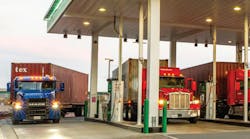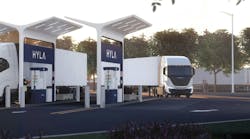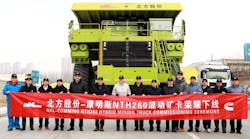The pitches are almost omnipresent in promotion for new equipment, particularly during the Tier 4 period: “Eight percent more fuel efficient than its predecessor.” “Burns the least amount of fuel in its class.” “Uses less fluid overall.”
How do manufacturers define these terms and reach their conclusions? Construction Equipment talked to five major manufacturers to find out.
Q: Do you draw a distinction between the terms “fuel consumption” or “fuel burn” versus “fuel efficiency”—and how do you define these terms?
Komatsu (Bruce Boebel, senior product manager): Fuel consumption is an actual measure of fuel used. Fuel efficiency is generally a comparison between fuel used and work accomplished. An example would be comparing material moved for a unit of fuel consumed.
Caterpillar (Jason Hurdis, senior market professional, Industry Solutions Division): Yes we do, because the terms are drastically different. Fuel consumption is defined as how much fuel used or burned, that is it.
Fuel efficiency accounts for the work done for every unit of fuel used. It’s like the mileage rating on your car. The most important issue isn’t really how many gallons you burn; it’s how far you can drive, or, in the case of heavy equipment, how much work you can accomplish, with every gallon or liter.
Volvo Construction Equipment (Eric Yeomans, product manager, GPPE Products): Fuel efficiency is what is important, not just fuel consumption, and [fuel efficiency] is the ability to move the most material (highest production) for the least amount of fuel.
Case Construction Equipment (Brad Stemper, solutions marketing manager): I do. Fuel consumption and fuel burn can also be related to fuel economy. With the advent of DEF and SCR systems with Tier 4-Interim and Final, fuel economy, burn and consumption are also turned into “fluid economy” and consumption. So when you’re talking about the fluid that you put in to generate power with the engine, it’s fuel and DEF. The common way I like to explain the difference between the economy and the efficiency is the economy is the payback or the usage of it, which is the gallons per hour—what’s being used for the amount of time.
Efficiency tends to relate to the productivity, the yards per gallon, the amount of earth moved, the distance operated. It’s more of the productivity relation to what you’re doing with the machine and how efficient it is, based on the amount of fluid you’re burning or using.
John Deere Construction & Forestry (Craig Timmerman, product marketing manager, engines and power trains): We tend to talk about fuel efficiency because it’s got that component in it that takes in productivity. So we’re interested in how much work a customer can get done, a measure of productivity, as well as how much fuel they’re consuming to do that work.
We measure that fuel efficiency in a variety of applications, so we’ll look at it, depending on the product and depending on the typical operation, in things like trenching, stockpiling, truck loading, grading. All of those are dependent on what application you’re looking at. We’ll also have a look at fuel consumption, even in idling conditions—conditions that per hour don’t consume a lot of fuel, but we know there are a lot of products that do a lot of idling, so it’s important we minimize how much fuel is being consumed during idle.
The other thing is when we talk about Tier 4-Final, we don’t just talk about fuel, we talk about fluid because now we’re consuming both diesel fuel and DEF. They’re both an expense to the operator and they’re both important to their bottom line.
Q: What’s your company’s final definition of fuel efficiency?
Komatsu: [Answered in the first question.]
Cat: In a single sentence, doing the work customers require while maximizing fuel efficiency and minimizing operating costs.
Volvo: Productivity at a rate considered optimal with regard to the amount of fuel consumed.
Case: Fuel efficiency is the productivity, the amount of fuel or fluid used, for a specific operation.
Deere: Amount of work done per unit of fuel. An example, with a four-wheel-drive loader, would be material moved per gallon.
Q: How do you come up with the percentage you use in touting a fuel savings percentage on a particular machine?
Komatsu: Testing. We will test fuel consumption in a working application versus our previous model or current competitors.
Cat: Simple; we conduct tests on the machine(s) in real-world applications. We have invested considerable time and resources into developing a comprehensive, accurate testing process.
Whether we’re testing a new Cat product versus a previous model or a Cat unit versus a competitor, we start with machines that match up as closely as possible from a specification standpoint.
We configure both machines similarly, for example, same boom, stick, bucket and [teeth or blades]. Then we run both machines in the same material, using the same operator, so skill level is not a factor.
We use the most precise tools available to measure work done and fuel burned. The goal is to control as many variables as possible to ensure valid results for production, fuel consumption, and fuel efficiency.
Volvo: The results are calculated/measured during extensive side-by-side testing, comparing the current or previous model with the new updated model. That way we can supply accurate results.
Case: You’re placing two machines, the previous model and the new model, in a head-to-head comparison on the same day, with the same environment, in the same operating conditions. Usually with the same operator or a group of operators that crossover between the machines.
Deere: We do something we call a productivity study, where we take our new machine and compare it to the old machine; it’s in a customer application, but it’s a controlled application. They are equivalently spec’d machines in side-by-side operations in the same environment, on the same day.
Q: How do you recommend equipment managers themselves measure fuel efficiency?
Komatsu: Using telematics is a great way to monitor fuel consumption. Using telematics is easy, clean and accurate.
Cat: Using Cat Product Link and Vision Link or other telematics solution is the easiest method. Product Link is an on-board system that automatically collects data while the machine works. Vision Link is a web-application that displays the data in a simple report format. The Vision Link report includes information about many factors including fuel consumption, idle time and fuel efficiency, if Caterpillar scales systems are used.
Another method is to manually track and record the production or materials moved for the hour, day, week or month and divide that number by the fuel consumed for the same time period.
Volvo: There are numerous ways to measure fuel efficiency nowadays thanks to advances in technology. On-board weighing is a great way to monitor how much material each machine or a fleet is producing—during a shift, daily and so on, and you can of course compare that to the amount of fuel that was consumed, and all this information is available through telematic systems like CareTrack, the Volvo telematics system.
Case: It really depends on what the equipment manager has at their disposal. A number of machines now have devices in them that relate real-time fuel consumption. You can jump into Case machines, other machines, or your automobile and see what your real-time fuel consumption is. It will tell you the number of miles per gallon or the number of gallons per hour based on what you’re doing right there.
Manufacturers have also started adding indicators that identify when you’re operating more efficiently compared to less efficiently. You can see green lights; there’s even a green leaf barcode in some of our machines that glows green when you’re operating more efficiently. Then you also have the external devices like telematics, where you can pull cumulative fuel consumed or cumulative dosing rate or fueling rate, such as gallons per hour over a timeframe so you can relate what’s going on in the machine, or a group of machines, and compare operators, conditions, and job sites.
Deere: From a very high level, what we recommend is that looking at not only the amount of DEF and diesel, but also what work is getting done, and how long did it take them to do it.
In terms of the actual nuts and bolts of how to go about measuring this, if they don’t have a fueling system or a DEF system, or a fueling service that’s keeping track for them, they can use the onboard telematics systems on our construction equipment for the measurement of fuel used. There’s an on-board counter and it continually keeps track of how much fuel the machine is consuming. It’s very accurate.
Q: Can a figure as small as 5 percent even be noticed, if so, how? (At what point-percentage does a reduction in fuel consumption become meaningful?)
Komatsu: Whether a reduction is meaningful is completely up to the equipment manager and owner. Five-percent reduction on a small, already fuel-efficient excavator may not be noticed. Five percent on a 20-hour-a-day 100-ton truck should be noticed and equals some big dollar savings. In our current construction and mining world, any reduction in fuel use, and a corresponding reduction in emissions, should be the goal of every operator and equipment manager.
Cat: Success in today’s environment is not usually measured in dollars, but in cents. Even a small difference in fuel efficiency directly impacts costs that directly impact profits, and the impact is multiplied across the entire fleet. With higher profits, customers improve their bonding capability, increase competitiveness and strengthen virtually every aspect of their business.
A 0.5-percent or 1-percent reduction in fuel consumption can result in huge profits depending on the machine and the number of machines in the fleet. Take a 0.5-percent reduction per hour times the number of hours worked per day, per week, per month and the result is a huge and often a surprising number.
Volvo: Yes, a 5-percent reduction can be noticed. On a machine that has 6 gph fuel consumption, and a 10-hour work shift, the customer would save 3 gallons of fuel per day; that’s $10.50 saving per day based on $3.50 per gallon. I am quite sure that if you were to ask customers, they would say that every reduction in fuel consumption is vital, provided that it doesn’t affect their productivity.
Case: It really depends on the application. A small company with a single machine, he’s the owner and operator of the machine, he’s going to notice that those smaller percentages have less impact. With the price of fuel...today we’re talking about a lower cost of fuel, but six months ago we’d be talking about a higher cost of fuel. That fluctuation in fuel efficiency between machines could be seen immediately when fuel costs were higher.
If you’re operating more efficiently, you’re going to pick up nuances of those 2- or 3-percent savings in that small operation. But when you talk with a fleet owner and they’re able to improve fuel consumption by 3 percent, 5 percent, or 2 percent, they’re going to see a noticeable impact to their bottom line in operating costs. If you put 2,000 hours on a machine and you get 2 percent more back on that machine over that time period, that’s significant at 3 or 5 gallons per hour and those 2,000 hours.
Deere: Every percent matters. Our customers go through hundreds and hundreds of thousands of gallons of fuel and DEF, and every percent hits their bottom line and their profitability of operation. So from a very elemental standpoint, everything matters.
Certainly, measuring fuel to 1, 2, 3 percent can be difficult for customers to execute, but it doesn’t make it any less important.
Q: How long should it take for managers to notice a difference?
Komatsu: Historical data from telematics on individual machines can highlight savings pretty quickly. But the key to fuel reduction is changing operator behavior and making that change sustainable.
Cat: Improvements can be or should be noticed in as little as one hour. However, I encourage customers to compare over a single shift or day depending on their operation. This helps account for other variables like idle time, environment changes, material changes, etc. The above is assuming, the customer or manager has recorded or established a known benchmark for comparison.
Volvo: With the information and technology that is available to customers, they should be able to notice on an hourly, and most certainly, daily basis.
Case: [See previous answer.]
Deere: It depends on how big the difference is; the larger that difference, the more quickly they’re going to be able to pick up the difference. And it really depends on how consistent the application is. For instance, a backhoe loader may do a different activity every day. It may be loading with the loader one day, it may be digging with the backhoe on a second day, so having a real good apples-to-apples comparison may be difficult on a product like that. But if it’s a four-wheel-drive loader feeding a hopper with the same size bucket on the same day, they can pick that fuel efficiency difference up in a matter of hours because the application is consistent.
Q: What came first, Tier 4-Final changes contributing to overall fuel efficiency, or the desire to offset/justify the price increase?
Komatsu: Komatsu engineers included fuel savings in their Tier 4-Interim and Final planning and goals.
Cat: Advances in technology, engine design and fuel development all play a role in Tier 4 engines being more fuel efficient than older models. It’s like today’s V6 engines. They produce a lot more horsepower than the big V8 engines of the past, but can travel 30 or more miles on a gallon of fuel. Caterpillar develops products from a systems perspective, taking the advancements in engine design to the entire machine platform. We bring together the best possible combination of components and subsystems with the goal of making everything—from the bucket tips to the brakes—work together as a single optimized system.
Volvo: When we developed Tier 4-Final technology, fuel efficiency, of course, was part of the development, but so was the benefit for customers, and that was fuel efficiency improvements that offset price increases.
Case: It goes back even a little bit further. You’re asking whether the solutions created the need or the opportunity for fuel efficiency, or whether the mandates created the need to offset the cost.
When the emissions regulations started coming into effect in 1996, then progressed through Tier 2 and Tier 3, those [target] numbers were pre-determined and then given to the OEMs. Emissions compliance provided an opportunity to take a giant step forward with technologies and increasing overall equipment efficiency. OEMs first concentrated on the next generation of emissions, and then began looking at the future emissions mandates.
In some of the cases, depending on the emissions, the product line, the horsepower range, or whatever, the [manufacturers] literally had to identify a new technology to create the solution that they needed. As those things happened, it was the new technologies that created efficiencies.
Deere: Undoubtedly, the focus on fluid efficiency came first. In our operations and the development of products, we’ve been running productivity tests, measuring fuel, and making fuel consumption goals for decades. Because it’s such a major contributor to our customers’ operating costs, it’s always been top-of-mind for us. The technology that enables Final Tier 4 emissions also enables an improved combustion efficiency, which adds some additional opportunity to improve fuel and fluid consumption. So, we took advantage of that opportunity with our Tier 4-Final machines.
Q: Any estimates about how long (if ever) the increased cost of a Tier 4-Final machine will be offset by higher fuel efficiency/reduced fuel consumption? (Is this a machine-specific consideration?)
Komatsu: [Did not answer.]
Cat: The point blank answer is, it depends. It depends on the machine, machine configuration, machine fuel-saving features, application, job site layout, idle time, operator technique, Tier 4-Final solution costs, operating hours and fuel prices. Obviously, the higher the fuel prices and higher operating hours, the larger the impact to operating costs and realized savings.
Volvo: This is a difficult question to give a definitive timeframe because it will all depend on how much the customer utilizes his equipment, and the fact that Tier 4-Final technology and cost differs on each product.
Case: It isn’t necessarily a machine-specific consideration, and it isn’t necessarily something that drives home to the fuel efficiency of the machine that is going to dictate a payoff on the solutions incorporated into it. Not all the equipment is used consistently to where we can dictate that, or provide a goal for that payback.
For instance, a skid steer can be used in a production application in a quarry, and never see a down moment. It can run 24 hours a day in some situations, and in other situations a skid steer will sit for many, many hours. It’s such a hard desire to say we’re going to drive the cost of this system to payback with efficiencies in “x” amount of time. Because as soon as we do that, we eliminate certain customers, certain applications, and so on. That’s just the dichotomy of not being able to keep every application in mind when you’re trying to create one solution.
Deere: There are many factors that impact the cost of our equipment beyond just the emissions system, although the emissions system has in recent years been a good chunk of the costs. We continually strive to lower our customers’ operating costs and that will remain a key component of our value proposition.
Our telematics systems are an additional cost we put into our product, but that additional cost also allows our customers to better manage their fleets, monitor their idle time, optimize their productivity, and ultimately, allow them to do more with less.
It’s tools like that that add cost to our machines, but they also add a lot of benefits to our customers. So it’s not just that Tier 4-Final emissions piece that’s impacting the cost of our equipment—there are other things going on. At the end of the day, we’re most interested in what value we can provide to our customers.





